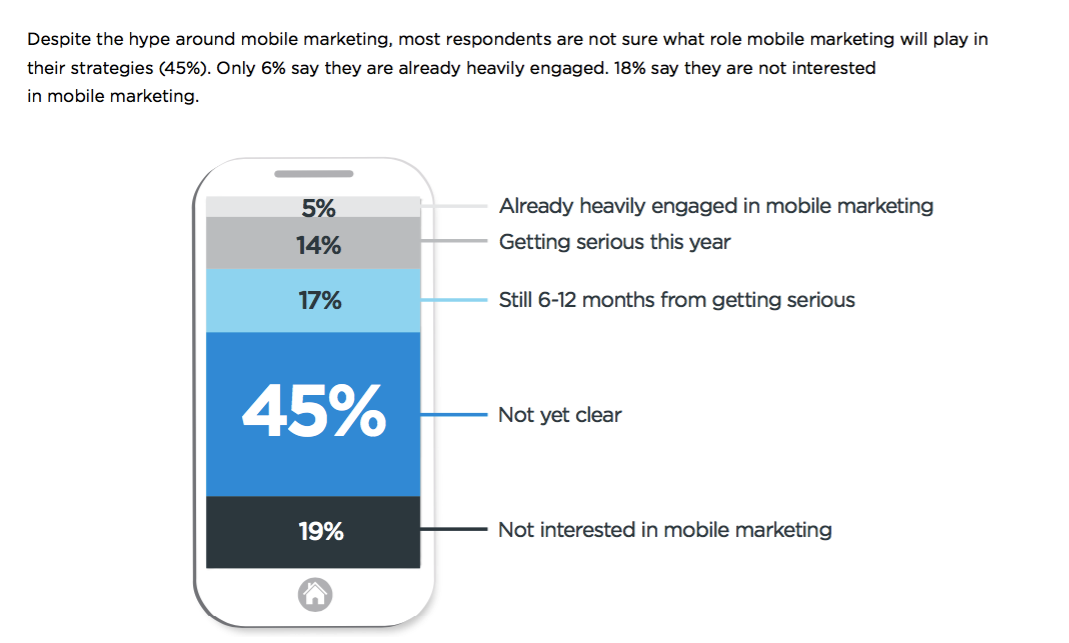
Does the word "Mobilegeddon" sound familiar to you? No, it's not the latest the end-of-the-world-as-we-know-it summer blockbuster. Of course, there is some lack of agreement as to the impact of Mobilegeddon but one thing that is certain: is that sites that are not mobile friendly are being affected by Google's latest Mobile-Friendly Algorithm. Hubspot's independent analysis of more than 15,000 of their customers’ websites showed that websites that aren’t mobile optimised had an average of 5% decline in organic traffic. The logical next step for marketers seems obvious: update sites to be mobile friendly and provide an experience that will reward the mobile users and advance the business interest of your company. For example, create a mobile ad that will hook your visitor. Right?
Wrong...
The B2B Technology Marketing Community on LinkedIn conducted a 2015 lead generation survey to better understand how B2B marketers are adjusting to new challenges, and to identify new trends and best practices. They were asked the question "What role does mobile marketing play in your marketing plan?"
Despite the hype around mobile marketing, most respondents (45%) reported that they were not sure what role mobile marketing will play in their strategies, and 18% said they weren't interested. Only 6% said that they were already heavily engaged in mobile marketing. However, current research shows that advertisers are willing to spend more money on mobile marketing. Mobile is where their demographic is, as mobile ad spend is slated to increase to upwards of $195 billion by 2019, from $68 billion for this year.
The Practical Part
Here is some practical advice on how to tap in on that mobile conversion. Start by relying on one of the oldest of the "best practice" section: an ad that touches on the following points:
- Mobile-friendly Website
- Call us from your mobile
- Put “Mobile” in your display URL
- Mobile-friendly landing pages
- Fast Mobile Content
- Make video mobile ready
Another option worth considering is to turn the contact forms into “click-to-call” buttons. Thus, instead of filling in contact forms, the user might want to call you immediately. After all, they are checking your site on their mobile phone. Calling is easier than typing. You can't just use the word "mobile" and expect overnight success. You should plan your mobile ad with the concept of "mobile" and not just add it as an afterthought. The users can and will spot the difference. Let's take for example the mobile landing page. It should only contain the crucial elements: name, phone and email. It's not a good idea to get users to fill out more than four fields. As a matter of fact, if you are planning on calling your leads quickly, you can skip the email altogether.
The Creative Part
Create Something Useful
The Start-Stop add is so useful and car-unrelated, it doesn't feel like a marketing at all. The app won't try to sell you cars, but it will establish the correlation between Audi and efficiency. If that's not good marketing, we don't know what is. The app itself is really simple: it detects open apps, which haven't been used for a while and sends notifications to close it, thus saving processing power and battery life. Additionally, this promotes Audi’s stop-start technology (automatically turning the car engine off when stationary). The way the app promotes Audi is so elegant, it doesn’t feel like promotion at all: it’s just an efficiency app.
Create Something Fun
This is an example of how to integrate an ad within your app.
Have you played Bitcoin billionaire? It is a mobile game where you tap to get virtual bitcoins and build your bitcoin empire. As most things simple, it is highly addictive. The best part is that it provides the option to monetise their game through ads.
Banner ads at the top or bottom of the screen or pop ups can be easily ignored. But how do you ignore the option of getting game advantages for actually watching the adds? Being part of the gameplay, the ads are not disruptive and don’t annoy the user. Thus, the engagement and click through rate are much higher.
Create Something New
As a B2B company, you are probably satisfying a niche in the business. This gives you plenty of opportunities to do something innovative without actually spending a lot of money. Think of something you needed and created to help your company run more smoothly. Maybe other people need the same know-how? Take for example Halifax’s Home Finder app. It is a tool for researching properties , and combines Zoopla data with an augmented reality layer and mortgage calculator.
Their results are astonishing: more than 20 million unique users reached with 0.90% CTR and more than 100k views of the demonstration video on YouTube.
Create Something to Connect Like Minded People
Maybe a lot of people in you business sector know each other cause you meet at conferences, but how often do you have the chance to discuss everyday issues? What if you actually made it easier to communicate and brainstorm together? What 3M’s Post-it® Plus app does is exactly this: enabling collaboration. The app is for iPhone and iPad allows users to capture images of their Post-it notes, and share them with other business people. Make sure you utilise the unique properties of mobile (touch screen, location tracking, and in-built camera) instead of just adjusting your desktop campaign to mobile. All of the examples above have one thing in common: they want to engage the users and leave them happy by helping or entertaining them. Think of what your target audience needs and provide a useful service which doesn’t feel like marketing at all.
If 50% of your traffic from Google comes from mobile devices, it's a good idea to spend more time working on your mobile marketing strategy. If you are not mobile-friendly, all of that traffic from mobile is at huge risk. Mobile is here to stay and impact business. All signs point to mobile slowly becoming the preferred device for both the consumer and the business. How are you getting ready?



